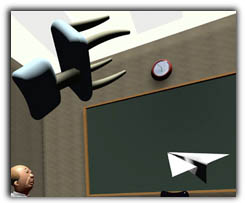![]()
Vol. 71, No. 9,
September 1998
The New Tort of Negligent Supervision
By Arnold Anderson
 Editor's
Note: To view Wisconsin statutory materials referenced in this
article you must have and/or install Adobe
Acrobat Reader 3.0 on your computer. Editor's
Note: To view Wisconsin statutory materials referenced in this
article you must have and/or install Adobe
Acrobat Reader 3.0 on your computer.
 In Miller v. Wal-Mart Stores Inc.,1 decided June 24, 1998, the Wisconsin Supreme Court
established the tort of negligent supervision in Wisconsin. On the same
day Miller was filed, the Wisconsin Supreme Court also handed down
Doyle v. Engelke,2
which held the insurance company had an obligation to defend the allegation
of negligent supervision.
Miller and Doyle establish the elements of the tort of
negligent supervision and its application to a liability insurance company's
duty to defend. However, much work remains before all the ramifications
of these two decisions will be known. This article outlines considerations
surrounding negligent supervision claims and what happens when insurance
questions are raised in the same case.
Theories of employer liability
With the Miller decision,
there now are at least three ways in which an employer can be held liable
for the acts of employees: 1) negligent supervision; 2) respondeat superior;
and 3) an employer who "knew or should have known" of the employee's
tortious conduct.
| Recent court decisions establishing the tort
of negligent supervision will impact employer liability and insurance coverage.
This article outlines considerations surrounding negligent supervision claims
and what happens when insurance questions are raised in the same case. |
Negligent supervision. In Miller, Wal-Mart employees stopped
Miller, accused him of stealing a swimsuit, and also created a ruckus in
the store's parking lot. No swimsuit was found on Miller. Miller filed an
action against Wal-Mart Stores Inc. alleging that the employees unlawfully
stopped, detained, searched, and interrogated him, which caused damages.
The jury found that Wal-Mart was not liable, through the acts of its employees,
for false imprisonment, battery, negligent infliction of emotional distress,
and loss of consortium claimed by Miller's spouse. However, the jury found
that Wal-Mart was negligent in hiring, training, and supervising its employees
and that this negligence was a cause of damage to Miller. The jury also
found that Wal-Mart did not have reasonable cause to believe the Miller
carried away or concealed unpurchased merchandise, and awarded $20,000 compensatory
and $30,000 punitive damages. The trial court entered judgment on the verdict
and the court of appeals certified the case to the Wisconsin Supreme Court.
The issue was whether the employer had a duty of care with regard to hiring,
training, and supervising employees. Miller held there was such a
duty.
For the duty to apply, first it must be foreseeable that employees entrusted
with specific duties and authority be properly trained and that the failure
to do so could result in harm to patrons. Second, if the employer fails
to properly hire, train, or supervise employees, it breaches its duty to
others. Third, there must be a causal connection between the conduct and
the injury. Two questions are necessary to establish causation: Was the
employee's wrongful act a cause in fact of the plaintiff's injury? Was the
employer's negligence a cause in fact of the employee's wrongful act?
The jury in Miller found the employees were not liable for false
imprisonment, battery, or negligent infliction of emotional distress and
loss of consortium. However, the jury found Wal-Mart negligent in hiring,
training, and supervising the employees and that this negligence was a cause
of damage to Miller. Wal-Mart argued that if negligent hiring, training,
and supervision was a tort, it should include an element that an underlying
tort be committed by the employee. Since the employees in Miller
were found to be not liable, then strictly speaking, there was no underlying
tort committed by the employees. All of the cases discussing negligent supervision
cited in Restatement (2d) of Agency, section 213 (1957), involved employees
who had committed a tort or actionable conduct against the plaintiff. Miller
sidestepped that issue. Miller did not require an underlying tort:
It simply held that a wrongful act is required and the wrongful act need
not be a tort. There was a wrongful act by the Wal-Mart employees, which
was the basis for the tort of negligent supervision claim. In this fashion,
Miller navigated around the fact that the jury exonerated the employees
of any tort.
The case was remanded to determine whether the elements of the tort of
negligent hiring, training, and supervision outlined in Miller could
be met. There was no remand with regard to the damage issues, and that portion
of the verdict was affirmed. Wal-Mart also had invoked section
943.50(3) of the Wisconsin Statutes, which immunizes a merchant from
civil and criminal liability if the merchant "acts in good faith and
any act authorized under this section is immune from civil or criminal liability
for those acts." The jury determined that Wal-Mart did not have reasonable
cause to believe that Miller had shoplifted, and that part of the verdict
was affirmed. Miller also noted that, in an appropriate case, if
a merchant is liable for negligent hiring, training, or supervision, the
merchant nevertheless may be immune from liability if the merchant meets
the elements of
section 943.50(3).
Respondeat superior. Miller outlined the necessary
elements of negligent supervision. In addition to the tort established in
Miller, the principles of agency law also may apply to an employer.
Agency law imposes vicarious liability on an employer if an employee is
acting within the scope of employment. Thus, in addition to tort law, principles
of agency law may impose liability on an employer.
 "Therefore, a claim for negligent supervision is
distinct from a claim for vicarious liability, in that the former is based
on tort principles and the latter is based on agency principles. More specifically,
with a vicarious liability claim, an employer is alleged to be vicariously
liable for a negligent act or omission committed by its employee in the
scope of employment. See Shannon v. City of Milwaukee, 94 Wis. 2d
364, 370, 289 N.W.2d 564 (1980)."3 "Therefore, a claim for negligent supervision is
distinct from a claim for vicarious liability, in that the former is based
on tort principles and the latter is based on agency principles. More specifically,
with a vicarious liability claim, an employer is alleged to be vicariously
liable for a negligent act or omission committed by its employee in the
scope of employment. See Shannon v. City of Milwaukee, 94 Wis. 2d
364, 370, 289 N.W.2d 564 (1980)."3
The liability of an employer for the acts of a servant within the scope
of employment has been around for more than 100 years:
"In such a case, where the wrongful act of the servant, though wilful,
is strictly within the scope of his employment, it is unnecessary that the
master should be at the same time sanctioned nor subsequently ratified of
the unlawful act, in order to be held liable for mere compensatory damages
... this is upon the theory that what one does by his servant acting within
the scope of his employment and for his benefit is the same, in legal effect,
as though done by himself."4
Arsand v. City of Franklin5reiterated
that when respondeat superior applies, the master must pay for the
torts of the servant. Agency law will "let the master answer."6
The difference in applying respondeat superior and negligent supervision
is best illustrated by a hypothetical. Assume the plaintiff was a bar patron
and was disturbing patrons by being loud and obnoxious. The bartender-enforcer
(employee) got sick of the plaintiff's antics and slammed the plaintiff
up against the wall and slapped the plaintiff across the face three or four
times causing injury. If the bar owner had instructed the bartender-employee
that the bar has a "get tough" policy with loud and obnoxious
patrons, and the only way to handle them is to slap them around, then the
employee probably was acting within the scope of employment. Vicarious liability
(respondeat superior) would attach and the owner is liable. Assume
further, however, that the bartender's conduct was so outrageous as to not
be considered within the scope of employment. With the new tort of negligent
supervision, the employer-owner of the bar still may be found liable for
negligent hiring (didn't check to find out if the bartender had done this
before); negligent training (hadn't told the bartender not to slap people
around); or negligent supervision (turned the bartender loose without any
monitoring).
"Knew or should have known" standard. L.L.N. v. Clauder
involved negligent supervision of priests. L.L.N. also set out a
standard of care for negligent supervision, which appears to be a separate
basis upon which liability of an employer can be based:
"Therefore, an employer is liable for negligent supervision only
if it knew or should have known that its employee would subject a third
party to an unreasonable risk of harm."7
This is a third avenue of liability against an employer. The "knew
or should have known" standard probably is harder to establish in most
cases than the tort outlined in Miller. However, there may be circumstances
where the plaintiff will want to apply the "knew or should have known"
standard, particularly if the level of culpability is important and punitive
damages are being sought. The "knew or should have known" standard
also may be relevant to insurance coverage issues.
In the hypothetical concerning the bartender (employee) and the bar owner
(employer), if the incident with the plaintiff was the second or third time
the bartender had slapped someone around, the court or jury probably could
find that the facts come within the "knew or should have known"
standard, and liability would be imposed on the employer without the necessity
of establishing negligent hiring, training, or supervision.
Verdict form. Litigants in Wisconsin now have at least three theories
of recovery against an employer when dealing with employee conduct: 1) the
tort of negligent supervision; 2) respondeat superior, that is, the
employee acting within the scope of employment when the damage was inflicted;
and 3) the employer "knew or should have known" that the employee
would subject a third party to an unreasonable risk of harm.8
The basic verdict questions concerning negligent supervision follow:
1) Did the employer have a duty to properly hire or train or supervise
the employee? If so,
2) Did the employer breach that duty? If so,
3) Was the employee's wrongful act a cause in fact of the plaintiff's
damages? If so,
4) Was the employer's negligence a cause in fact of the employee's wrongful
act?
5) What amount of money will fairly and reasonably compensate the plaintiff
for damages sustained as a result of the employee's (or employer's) conduct?
The doctrine of respondeat superior could add another question
to the verdict:
6) Was the employee, at the time of his or her conduct, acting within
the scope of his or her employment?
If the answer is yes, there may be no need to go into issues of negligent
hiring, training, and supervision. The conduct of the employee within the
scope of employment is conduct of the employer.
Finally, if applicable, the jury also may be asked if the employer "knew
or should have known" the employee would cause harm or injury.9
Next Page
|
